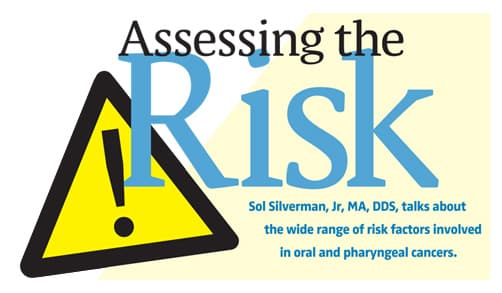
Assessing the Risk
Sol Silverman, Jr, MA, DDS, talks about the wide range of risk factors involved in oral and pharyngeal cancers.
Q. What are the most important risk factors for oral cancer?
A. Cancer is a multifactorial disease, meaning that many causes are behind its development. Risks vary from patient to patient but genetics are fundamental to who develops cancer. For example, cells possess suppressor proteins. If these proteins are modified or mutated, the patient becomes more susceptible to developing tumors. Along with genetics, other factors have an impact. Tobacco users are at a higher risk, which varies on the form used, the duration of time used, and how much was used. Alcohol use is also a risk factor but we’re not sure how much alcohol is good and how much is bad. Someone who drinks wine and beer, which have a lower alcohol content, may be less at risk than someone who drinks whiskey, which has a high alcohol content.
Epidemiologic and laboratory studies indicate that nutrition is a factor.1,2 Emerging evidence suggests that diets low or deficient in fruits and vegetables put people at a higher risk not only for oral cancer, but all sorts of other diseases. Further, anti-inflammatory and antioxidant proteins have been identified in fruits and vegetables that are linked with carcinogenesis.1 New evidence is coming out about a potential obesity link and oral cancer. Also, sunlight is a risk factor for lip cancer. Again, because of the multifactorial nature of cancer, there is great patient-to-patient variation.
Q Is age a risk factor in itself?
A Certainly, age is an important factor in any cancer but an increasing number of cancers occur in younger people. But on the whole, cancer is a disease of age. This makes sense because as we get older, our body chemistry changes—it has been exposed longer to viruses, to pollutants in the air, various types of foods, and many other potentially carcinogenic agents. Medicine’s purpose is to extend age and as human longevity increases, so does the incidence of cancer. Recently the big news story was that the number of deaths from cancer is decreasing. On the other hand, data also show that new cancers are slowly increasing. We’re curing some cancers, and people are living longer with cancers, but prevention by reducing risk factors is still the best defense.
Q. Does oral cancer affect younger people?
A. Unfortunately, more oral and pharyngeal cancers are being diagnosed in younger people (under 40) without traditional risk factors. They don’t smoke, they don’t drink alcohol, their immune systems are still intact, so we don’t understand why this is taking place. These cancers are most likely due to unknown genetic mutations. While certainly cancer and oral and pharyngeal cancer are diseases of the aging population with more than 95% of these occurring in individuals over 40, the number of cases in those under 40 is increasing. This extends the criteria for performing routine oral cancer examinations to all adult patients.
Q. Is this phenomenon linked to a virus?
A. Whereas no evidence exists linking oral or pharyngeal cancer with the herpes virus, evidence does indicate a possible link to the human papilloma virus (HPV). More than 100 types of HPV exist. The most common is HPV 16, which is strongly linked as a causal agent with cancers of the uterine cervix and the anorectal epithelium. Extensive research is now underway on identifying the HPV virus in precancerous lesions, eg, some forms of leukoplakias. The evidence so far is somewhat mixed.3,4 HPV 16 definitely plays a role in cancers of the tonsillar area, probably the fastest increasing site for oropharyngeal cancers.
All of these new data emphasize the importance of the oral cancer examination. It’s not only palpating the neck but having the patient say “ah,” so you can look at the oropharynx, which includes the tonsillar fossae. Oral pharyngeal cancers are important responsibilities of the dentist and dental hygienist relative to prevention and early detection.
REFERENCES
- Pavia M, Pileggi C, Nobile CG, Angelillo IF. Association between fruit and vegetable consumption and oral cancer: a meta-analysis of observational studies. Am J Clin Nutr. 2006;83:1126-1134.
- Suzuki T, Wakai K, Matsuo K, et al. Effect of dietary antioxidants and risk of oral, pharyngeal and laryngeal squamous cell carcinoma according to smoking and drinking habits. Cancer Sci. 2006;97:760-767.
- Kansky AA, Seme K, Maver PJ, Luzar B, Gale N, Poljak M. Human papillomaviruses (HPV) in tissue specimens of oral squamous cell papillomas and normal oral mucosa. Anticancer Res. 2006;26:3197-3201.
- Syrjanen S. Human papillomavirus (HPV) in head and neck cancer. J Clin Virol. 2005;32(Suppl 1):S59-S66.
From Dimensions of Dental Hygiene. February 2007;5(2): 34.

